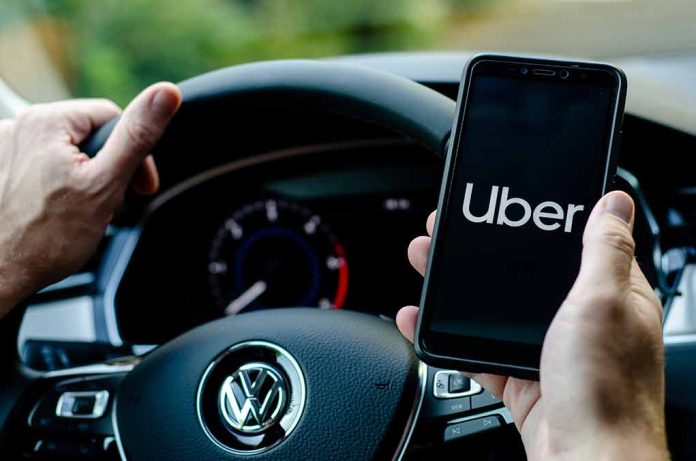
Uber’s latest partnership with Volkswagen will bring autonomous electric vans to American roads by 2026, challenging Tesla as the Trump administration eases self-driving regulations.
Key Takeaways
- Uber and Volkswagen will launch a fully autonomous, electric rideshare service using the ID. Buzz AD vehicles in Los Angeles by 2026.
- This marks the first autonomous vehicle fleet specifically designed for shared rides, potentially making ride-pooling profitable for Uber after previous struggles.
- The service is powered by autonomous software developed jointly by Volkswagen subsidiary MOIA and MobilEye, utilizing advanced sensor technology and crowdsourced mapping.
- Testing of the autonomous vehicles will begin in 2025, with plans to expand the service across the United States.
- The Trump administration’s regulatory environment is favorable for autonomous driving technology deployment, helping accelerate adoption.
American Innovation Leading the Way
In a strategic move positioning American transportation technology at the global forefront, Uber has partnered with Volkswagen to launch a groundbreaking autonomous rideshare service using all-electric vehicles. The service, set to debut in Los Angeles in 2026, will utilize Volkswagen’s ID. Buzz AD, a modern reimagining of the classic Microbus that can accommodate up to seven passengers. This initiative directly benefits American consumers by providing innovative, environmentally friendly transportation options while creating new technology sector jobs.
We’ve said it before: the future of transportation is electric, shared, and autonomous. Our next product combines all three! Autonomous technology will drive a safer and more affordable future for everyone, and we can’t wait to expand access to it around the world, said Uber in their official announcement.
Thousands of VW's ID Buzz electric vans will lay the foundation for Uber's new commercial autonomous driving taxi service when it launches in LA in late 2026.https://t.co/HywySR7She
— Jalopnik (@Jalopnik) April 24, 2025
Economic Benefits and American Leadership
The partnership represents a significant advance in American transportation infrastructure and positions the U.S. ahead of global competitors in autonomous vehicle technology. Testing of the autonomous ID. Buzz service will begin in 2025, with a commercial launch the following year. Notably, this innovative approach comes as the Trump administration has eased regulatory barriers to autonomous driving technology, allowing American companies to innovate more freely while maintaining essential safety standards.
“Shared, electric and autonomous,” said Sachin Kansal, Uber’s Chief Product Officer, describing the company’s vision for the future of mobility.
Uber has already been expanding its autonomous vehicle offerings through partnerships with Waymo, currently operating in Austin, Texas, with plans to launch in Atlanta. These initiatives have resulted in an impressive annual run-rate of 1.5 million autonomous vehicle trips. The Volkswagen partnership specifically targets shared rides, which could finally make services like UberX Share profitable by eliminating driver costs while maximizing vehicle occupancy.
🚗 Uber Doubles Down on Affordability With Route Share & Pass Expansion
— 💸 Uber launches Route Share — fixed-route shared rides at 50% the cost of UberX
— 🕒 Pickups every 20 mins during weekday rush hour in NYC, SF, Chicago
— 🧾 Company eyes employer partnerships for pre-tax…— AFV GLOBAL (@afvglobal) May 14, 2025
Advanced Technology and Safety Focus
The autonomous ID. Buzz vehicles will utilize cutting-edge technology developed jointly by Volkswagen subsidiary MOIA and MobilEye. This advanced system incorporates multiple sensors including cameras, imaging radar, and LiDAR technology to ensure safe operation. MOIA has been testing similar autonomous ride-pooling services in Hamburg, Germany since 2021, providing valuable data for the American rollout.
“The autonomous software that will power the ID.Buzz fleet is a joint development between [Volkswagen subsidiary] MOIA’s fleet operations and MobilEye. This system relies on more than a dozen sensors, including cameras, imaging radar, and LiDARs. It also uses crowdsourced mapping from millions of Mobileye-equipped vehicles for data on roads and typical driver behavior,” explained Volkswagen’s Mark Gillies.
Strategic Competitive Advantage
This partnership gives Uber a significant advantage over competitors like Tesla, which has only shown a prototype of its larger “robovan” concept. By bringing autonomous minibuses to market first, Uber and Volkswagen are capturing a critical segment of the future transportation landscape. The retro-styled, all-electric ID. Buzz also provides a distinctive visual identity that could attract consumers looking for unique transportation experiences.
“Through our work with Uber, we’ll introduce the ID. Buzz, the reimagined version of the iconic Microbus in all-electric form, to a growing number of riders in the years to come,” said Kjell Gruner, Volkswagen of America CEO.
As Uber continues to innovate in transportation technology, the company is simultaneously introducing new pricing options including ‘route share’ for affordable rides and a ‘price lock pass’ for predictable fares. These initiatives, combined with the autonomous vehicle program, demonstrate America’s continued leadership in developing practical transportation solutions that benefit consumers while advancing technological capabilities.







